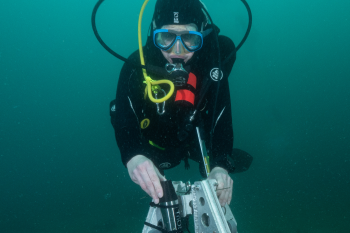© Pint of Science, 2025. All rights reserved.
As the end of October approaches, spider-inspired paraphernalia proliferates.
At any other time of year we might avoid them, evict them or worse, but one night a year they are everywhere, in edible, wearable and decorative forms. Arachnophobia suddenly offers an adrenaline rush! But fearsome beasts they may not always be. In fact, here are eight reasons to hail this Halloween hallmark.
Spiders can fly. The idea of airborne arachnids might not always be appealing but hang with me here. Through a process known as ballooning, a spider can climb to a prominent point (say, a leaf, a branch or the top of a fence), let out a strand of silk and take to the sky. They don’t even need a breeze to carry them away. Instead, spiders can sense natural electric fields in the atmosphere and make use of them to move up and down in the air. (Bees use these electric fields too, as they interact with flowers and communicate in the hive.)
Spiders can sense through their legs and their webs. Spiders are recognised experts at detecting movement in the environment. Through their webs and special cells on each of their legs, they can detect prey, find mates and avoid predators of their own. They can even compare input from individual legs. Feeling bio-inspired? A growing understanding of these sensory abilities could lead to innovative engineering in the realm of sound control and amplification.
Spider eyes see in more ways than one. Spiders, particularly those of the jumping variety, don’t catch their prey in webs. Instead, they rely on a two-part vision system. Of the eight eyes jumping spiders have in total, three pairs are positioned around the spider’s head to detect motion in the surrounding environment. Meanwhile, two forward-facing primary eyes move independently of the head and provide colour vision of remarkable resolution.
If you’re starting to see your own eyes in a different light, here’s a dazzling distraction: to our eyes, spider eyes glow. Take a torch out into a garden or green space at night and hold it up to your eye line (or wear a headlamp). Shine the beam down on the ground to see what looks like a scattering of gemstones. But gems they are not; wolf spider eyes they almost certainly are. The luminescence you see is down to a shiny layer at the back of the eye known as the tapetum. It helps intensify a spider’s sight and gives us a unique view too. (Just don’t give your torchlight too much credit—artificial light exposure in cities and suburbs could be shrinking spider brains.)
In brighter news, spider venom could save farmers’ crops from pests. Crop yields need to grow to feed a growing population, but traditional pesticides are a problematic tool for achieving this. Increasingly these pesticides are hampered by resistance and unintended health and environmental impacts. Enter: proteins from the venom of the Blue Mountains funnel web spider. Isolated and then synthesised in the lab (for scale), these compounds can be used to create products that will put a stop to pests without harming us or, indeed, critical pollinators like bees.
The benefits of venom don’t stop at crops. In fact, spider venom could one day save your life. From the complex cocktail of molecules that make up spider venom, one from a (different) Australian funnel web is currently under investigation for its ability to protect the cardiovascular system from damage during a stroke. Another is being tested for the treatment of epilepsy. As in agriculture, these peptides offer specific and targeted therapeutic potential.
Setting venoms aside in favour of arachnid architecture, spiders’ webs could be ecologists’ next survey tool. As researchers in Western Australia have found, these woven wonders prove a valuable tool for catching more than prey. From 49 webs sampled, they found the genetic traces of 85 other species. These genetic markers, formally known as environmental DNA, or eDNA, could be used to monitor biodiversity without the invasiveness or intensity of traditional survey methods. What could webs say about the biodiversity in your backyard?
Finally, a spiel on spiders wouldn’t be complete without a nod to the native Australian peacock spider, which aptly demonstrates how spiders dance and do so in colour. Peacock spiders in particular make up for their small size (they’re only two to six millimetres long) with colour and character. They have scales of ‘splendid colouration’ and ‘unusually ornamemted’ legs that all play a part in attracting a mate. In 2011 only seven species of peacock spider were known to science. Today, thanks to dedicated academics and citizen scientists alike, more than 80 have been characterised. So, if you’re looking to decorate this Halloween, perhaps the traditional tarantula could take a backseat in favour of the nemo spider, the deep blue spider or the starry night spider.
While you might let spiders and their spooky sidekicks strike fear into your heart on Halloween, I hope that when November arrives you’ll remember just how remarkable they are year-round.
References
Fowles, T. (2021). Spider venom to be developed into insecticide against locusts. Available at: https://www.usc.edu.au/about/unisc-news/news-archive/2024/may/spider-venom-to-be-developed-into-insecticide-against-locusts
Morley, E.L. and Robert, D. (2018). Electric Fields Elicit Ballooning in Spiders. Current Biology, 28(14), pp.2324-2330.e2.
Newton, J.P., Nevill, P., Bateman, P.W., Campbell, M.A. and Allentoft, M.E. (2024). Spider webs capture environmental DNA from terrestrial vertebrates. iScience, 27(2), pp.108904–108904.
Powley, K. (2024). Testing new spider venom epilepsy drugs | The Florey. Available at: https://florey.edu.au/news/2024/09/using-lab-grown-organs-to-test-new-spider-venom-epilepsy-drugs/
Schubert, J. (2021). Maratus nemo: A new wetland species of peacock spider from South Australia (Araneae, Salticidae, Euophryini). Evolutionary Systematics, 5(1), pp.71–80.
Stavenga, D.G., Otto, J.C. and Wilts, B.D. (2016). Splendid coloration of the peacock spider Maratus splendens. Journal of The Royal Society Interface, 13(121), p.20160437.
The Australian Museum (2022). How Spiders See the World. Available at: https://australian.museum/learn/animals/spiders/how-spiders-see-the-world/
UQ News (2024). Spider venom heart drug moves to clinical trials. The University of Queensland. Available at: https://www.uq.edu.au/news/article/2024/10/spider-venom-heart-drug-moves-clinical-trials
Willmott, N.J., Black, J.R., McNamara, K.B., Bob and Jones, T.M. (2024). The effects of artificial light at night on spider brains. Biology Letters, 20(9).
Winsor, A.M., Remage‐Healey, L., Hoy, R.R. and Jakob, E.M. (2023). Visual attention and processing in jumping spiders. Trends in Neurosciences, 47(1).
Wu, J., Miller, T.E., Cicirello, A. and Mortimer, B. (2023). Spider dynamics under vertical vibration and its implications for biological vibration sensing. Journal of the Royal Society Interface, 20(206).




